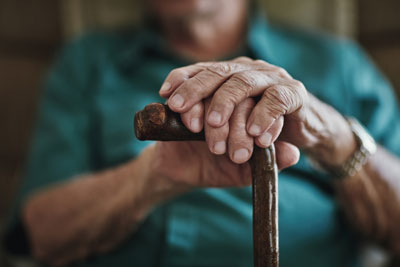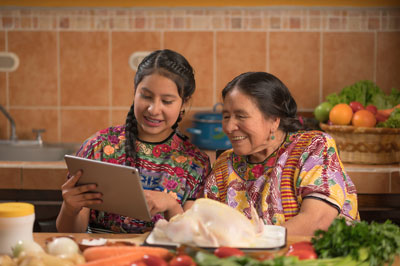Honoring Life: Intergenerational Mental Health Awareness and Resilience through Community
 By Courtney Davis, MS
By Courtney Davis, MS
If you or someone you know is experiencing a mental health crisis, please contact the National Suicide Prevention Lifeline by calling or texting 988.
An intergenerational approach and understanding of mental health strengthens tribal and urban Native communities through identity and connectedness. Understanding mental health is one part of suicide prevention. By helping others in crisis through increasing communications, we change the conversation by decreasing the stigma around suicide and save lives. Suicide is a national public health crisis that is preventable with the right resources and interventions.
In this article, we explore the concepts of loneliness, isolation, resilience, and engagement. After a worldwide pandemic, we know the implications of isolating from others physically and that combating loneliness is vital in preventing long-term adverse health impacts. It is important to recognize that a person can be isolated without feeling lonely and at the same time acknowledge diverse experiences within every age demographic.
The Suicide Prevention Resource Center lists the following as risk factors for loneliness and social isolation in older adults:
- Social: Living alone, loss of significant other, family separation, few friends, being a caregiver for spouse
- Psychological: Depression, anxiety, dementia
- Physical: Poor health, serious illness, decreased mobility, loss of independence
- Economic: Limited financial resources
- Logistical: Loss of driver's license, lack of transportation
How can communities address risk factors and measure loneliness?
 The first step in engaging older adults is determining readiness.
The National Resource Center for Engaging Older Adults, or engAGED,
has developed a toolkit to support organizations in efforts to increase social engagement in their communities.
One resource includes these summarized steps:
The first step in engaging older adults is determining readiness.
The National Resource Center for Engaging Older Adults, or engAGED,
has developed a toolkit to support organizations in efforts to increase social engagement in their communities.
One resource includes these summarized steps:
- Meet with your staff to obtain buy-in and brainstorm.
- Identify and collaborate with community partners.
- Utilize the UCLA Three-Item Loneliness Scale to identify isolated or lonely older adults.
- Develop or enhance social engagement as a core part of the organization's programming.
Visit their website for the complete Community Awareness Toolkit or engAGED Innovations Hub for additional ideas.
How can Native Elders improve physical and mental health through resilience?
According to the Stories of Resilience Model by Reinschmidt et al. (2016), Native Elders define three concepts tied to resilience: individual, family, and community. When speaking to the historical trauma that contributed to the sense of loss related to boarding schools, language, culture, traditions, and family life, Native Elders addressed negative coping strategies that have led to broken families, health disparities, and a generational gap. In a few words, the resilience concepts defined as such:
- Individual: Personal strength grounded in identity and spirituality
- Family: Positive family relations allowing for cooperation and togetherness
- Community: Individuals and families connect language, culture, and tradition to implement positive social, political, and economic strategies
How can Title VI programs offer social activities to Native Elders?
 Under the Older Americans Act, the purpose of
Title VI is to “promote the
delivery of nutrition, supportive and caregiver services to American Indians, Alaskan Natives, and Native
Hawaiians” with a goal to “support the independence and well-being of tribal Elders and caregivers
living in their communities with nutrition, supportive services for Elders, and caregiver services.” The
Administration for Community Living/Administration on Aging defines social events as “a public
performance, entertainment, or function to promote social interactions and decrease isolation.” Check with
your regional administrator on whether social events are eligible under the Title VI grant funding allocation.
Under the Older Americans Act, the purpose of
Title VI is to “promote the
delivery of nutrition, supportive and caregiver services to American Indians, Alaskan Natives, and Native
Hawaiians” with a goal to “support the independence and well-being of tribal Elders and caregivers
living in their communities with nutrition, supportive services for Elders, and caregiver services.” The
Administration for Community Living/Administration on Aging defines social events as “a public
performance, entertainment, or function to promote social interactions and decrease isolation.” Check with
your regional administrator on whether social events are eligible under the Title VI grant funding allocation.
Beyond Bingo
Bingo is a beloved game for the ages and this Native girl loves a good Bingo session. Thinking outside the box, look to Kris Frankel's blog on the Arbor Company for a list of social activities:
- Walking and gardening clubs: According to the National Resource Center for Native American
Aging's (NRCNAA) Identifying Our Needs: A Survey of Elders, walking and gardening were the two of the most
common ways Native Elders exercise. This is also great way to get the whole family or youth involved!
- Group exercise: Visit the Well-Balanced page on the NRCNAA website to access a group program designed specifically for Native American Elders.
- Traditional storytelling or live music: Host a monthly storytelling or live music opportunity. Ask an Elder if they would like to share or bring in a local historian or musician to allow attendees to enjoy. Sharing knowledge strengthens a community body and music has proven to be therapeutic.
- Art and culture classes: Tap a local Native artist or community member for ideas on a coordinated paint night, jewelry making, or sewing circle.
- Field trips: Visit a local event and coordinate transportation for elders. In a recent webinar, the Shoshone-Bannock Tribal Elder Program discussed field trips to the Idaho State Fair and Indian Relay Racing events.
- Spa days: Self-care fosters well-being. Communities can coordinate with professional cosmetologists to offer haircuts, manicures, and skin care treatments. As a bonus, there are tons of do-it-yourself tutorials for spa masks.
Any of these ideas are easily adaptable to fit cultural and community needs, as well as program capacity. Make it your own and see what works. Be sure to invite families and community members to participate in planning, donating, and/or attending to decrease the intergenerational gap.